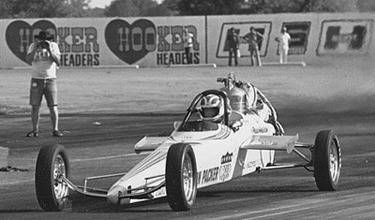|
Miller definitely had his ups and downs. The car qualified at that year's
NHRA Summernationals but caught fire in a first-round loss to Leroy
Goldstein in the Ramchargers Dodge Challenger and sustained significant
body damage.
Miller rebounded in excellent form, though, winning the inaugural NHRA
LeGrandnational Molson in St. Pie, Quebec, topping Phil Castronovo's
Custom Body Dodge in the final. He set low e.t. and top speed for Funny
Car at that event with a 7.01/216.86.
The 1971 season closed in rather spectacular fashion for Miller at
the New England Funny Car Nationals in Epping, N.H. While racing Lew
Arrington's "Brutus" Mustang, the blower exploded on Miller's Plymouth
shredding the body and bringing his year to a spectacular September
halt. [nbVanishing.jpg]
The New Jerseyite raced Funny Cars from 1972 through 1973 and Fred
Forkner's Top Fuel dragster in 1974, and that was pretty much the end
of his piston-driven race car, period. Somewhere in the early part of
the 1975 season, Miller saw a signpost on the road up ahead that said
"Next Stop, the Twilight Zone," and his career took a radical, radical
turn.
*************************************
To back track a little, on November 11, 1971, Vic Wilson stunned the
drag racing world with an unbelievable exhibition run at Orange County
Int'l Raceway in Southern California. Wilson wheeled the "Courage of
Australia" rocket dragster to a 5.107/311.41-mph charge that left fans
gasping for breath. Top Fuel cars were averaging runs in the low 230-mph
range at 6.30s and 6.40s (actually Don Garlits was the only driver in
the 6.20s) and for some drag race vehicle to run a second quicker and
80-mph faster was unbelievable.
The "Courage of Australia" was a 27-foot, 6-inch long, needle-shaped,
moncoque-bodied dragster with a rear-mounted, hydrogen peroxide-fueled,
silver screen catalyst, thrust rocket engined machine that developed
an estimated 6,100-pounds of thrust and 12,000 horsepower. When word
got out about what this wild machine had done, it brought the most daring
of daredevils out of the woodwork. In the pack of racers mesmerized
by this new breed of racing beast was Sammy Miller.
*************************************
Twenty-nine years; Miller recalled why and how the needle (as in dragster)
got sunk into his psyche.
"Oh man, I've always liked to go fast," he said. "However, the fuel
cars were costing me more than I was making. That and some of the politics
in fuel racing. I also had a bad Funny Car fire at the 1972 Indy race
and I wound up in the hospital for six months. I tried to keep the ball
rolling; I built a stocky mid-engine fuel dragster and raced a '75 Mustang
II a couple of times, but the budget was getting to be a problem.
"I knew about the rockets, but hadn't paid that much attention to them.
You know, I had things of my own to worry about. However in 1974, I
was at the eighth-mile track in Charlotte, North Carolina and the first
big rocket dragster, Tony Fox's "Pollution Packer" rocket dragster was
there with Dave Anderson driving. I was 100 feet away when Anderson,
who I thought was the best rocket driver at the time, couldn't get the
car stopped and went into two B/Fuel Dragster guys who were shut off
on the top end. All three of them were killed.
"A few days after the wreck, I called Tony after seeing an ad in Drag
News. He had put out an advertisement in the trade papers asking for
information on the crash, witnesses, that sort of thing. I contacted
him and flew out to his house in Minnesota. At the time, Vern Anderson,
a standout Top Fuel driver and no relation to Dave, was driving the
car for Fox in 1974, but decided to quit at the beginning of 1975. When
I was out there on the ad deal, he asked if I'd like to drive and I
said I would. He told me that if Anderson ever quit I would be the replacement."
 |
|
DRO file photo
|
During the winter, Fox had his "Pollution Packer" at Irwindale Raceway
in Southern California and Miller dropped by to see him. Fox, in turn,
dropped him in the seat to see what Miller could do.
"They (officials) restricted me to 280-mph for my first run," said
Miller. "I ran exactly 280-mph. I thought before the run that I'd be
really wowed by the pass, but I have to say I wasn't all that impressed.
Well, the next run was a little different, Tony bangs up the nitrogen
pressure in the air bottles when I told him I wasn't all that impressed.
The total pressure had gone up from 400-pounds to 600-pounds. This run
was a little more impressive. My time slip read 348-mph, but it wasn't
announced over the P.A."
*************************************
|